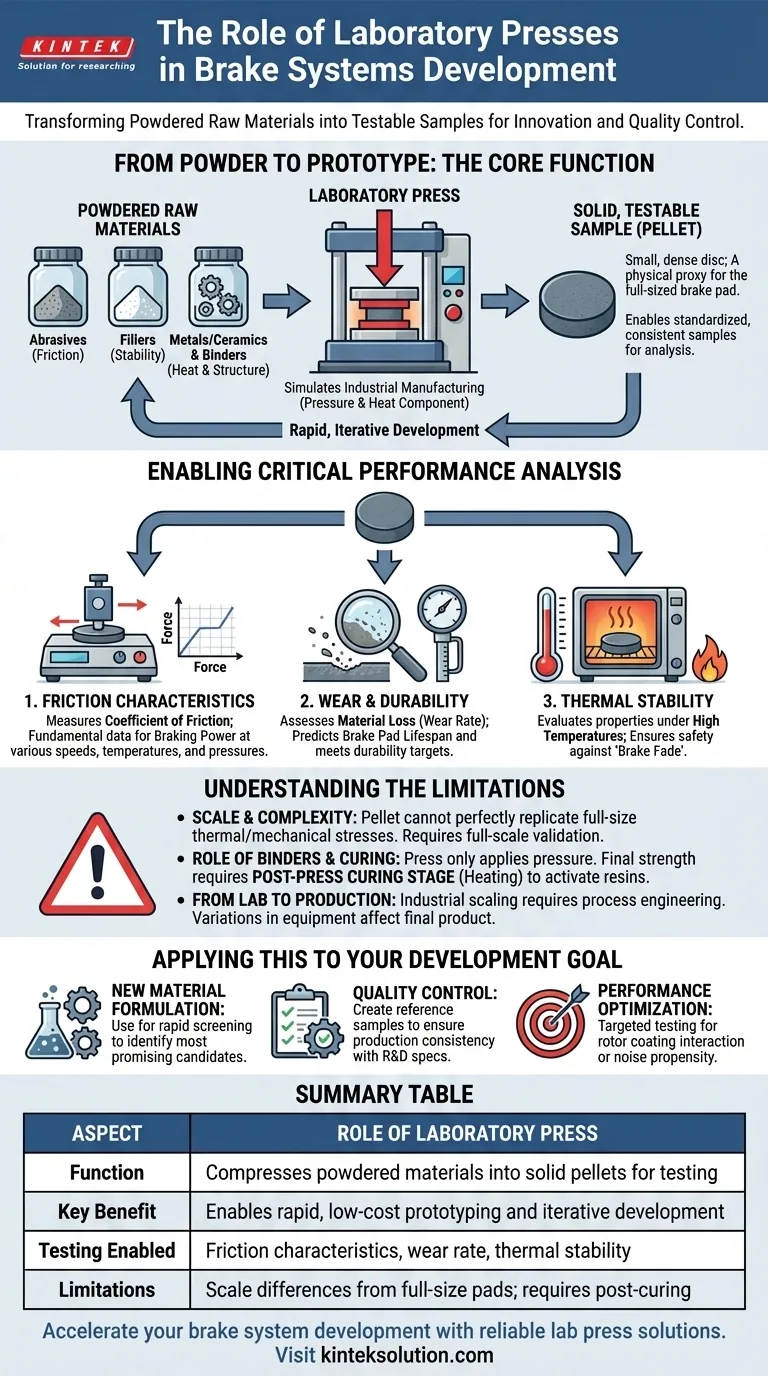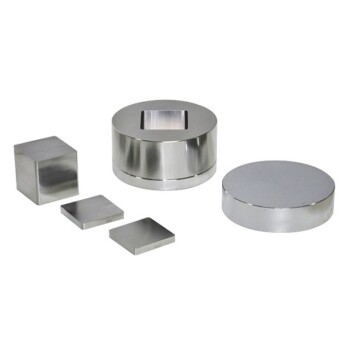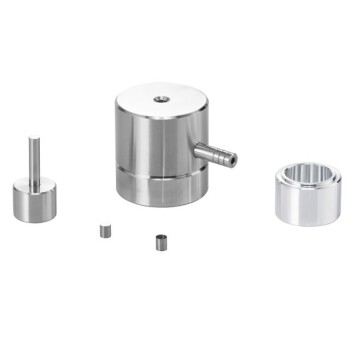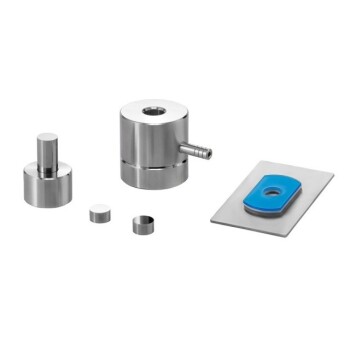In the development of advanced brake systems, laboratory presses serve a single, critical function: to transform powdered raw materials into solid, testable samples of a new brake pad. This process allows engineers and material scientists to precisely formulate, prototype, and analyze the performance of friction materials in a controlled, low-cost environment before committing to expensive, full-scale manufacturing and testing.
The laboratory press is the fundamental bridge between raw material science and real-world braking performance. It enables rapid, iterative development by simulating the industrial manufacturing process on a small scale, allowing engineers to test and refine friction material formulas for safety, durability, and feel.
From Powder to Prototype: The Core Function
The journey of a brake pad begins not as a solid block, but as a complex mixture of carefully selected powders. The laboratory press is the first tool used to give this mixture physical form.
Simulating the Manufacturing Process
Industrial brake pad manufacturing involves compressing a blend of friction materials into a mold under immense pressure and heat. A laboratory press replicates the pressure component of this process on a much smaller, more controlled scale.
This simulation is crucial for R&D, as it provides an early, accurate indication of how the material will behave during mass production.
Creating Testable Samples (Pellets)
The primary output of a lab press in this context is a small, dense disc or "pellet." This pellet, typically just a few centimeters in diameter, becomes a physical proxy for the full-sized brake pad.
By creating standardized samples, engineers can ensure their subsequent tests are consistent and comparable across dozens or even hundreds of different material variations.
Why Powdered Materials?
Brake pads are sophisticated composites, not simple materials. Their formula includes a mix of abrasives for friction, fillers for stability, metals or ceramics for heat transfer, and binders to hold it all together. Each ingredient exists as a powder, and the press is what physically consolidates them into a functional matrix.
Enabling Critical Performance Analysis
Once a sample pellet is created, it becomes the subject of intense analysis. The press enables the creation of material that can be subjected to tests that predict its real-world performance.
Measuring Friction Characteristics
The most important property of a brake pad is its coefficient of friction. Engineers use a device called a tribometer to slide the sample pellet against a disc made of brake rotor material. This test measures the friction generated under various speeds, temperatures, and pressures, providing the fundamental data for braking power.
Assessing Wear and Durability
The same tribometer tests also measure how much material is lost from the pellet during use. This wear-rate analysis allows engineers to predict the lifespan of the brake pad and ensure it meets durability targets.
Evaluating Thermal Stability
Brakes can reach extremely high temperatures during heavy use, which can cause "brake fade"—a dangerous loss of stopping power. Pellets are heated in ovens or during testing to analyze how their friction properties change at high temperatures, ensuring the material remains stable and safe under stress.
Understanding the Limitations
While indispensable, a laboratory press is a screening tool, not a final validation instrument. Understanding its limitations is key to a successful development program.
Scale and Complexity
A small pellet cannot perfectly replicate the thermal dynamics and mechanical stresses experienced by a full-size brake pad mounted in a caliper. Heat dissipates differently, and the stresses are not uniform. Lab results must always be validated with full-scale dynamometer and vehicle testing.
The Role of Binders and Curing
The press itself typically only applies pressure. The final strength and properties of a brake pad come from heating (curing) the composite, which activates the phenolic resins that bind the materials. Lab testing protocols must include a post-pressing curing stage that mimics the industrial process to yield accurate data.
From Lab to Production
A formula that works perfectly in the lab may face challenges in mass production. Slight variations in industrial presses, molds, and curing ovens can alter the final product. Significant process engineering is required to scale a successful lab formula while maintaining its desired properties.
Applying This to Your Development Goal
Your use of a laboratory press should be directly tied to your specific objective within the brake development lifecycle.
- If your primary focus is new material formulation: Use the press for rapid screening, creating dozens of sample pellets with minor formula variations to quickly identify candidates with the most promising friction and wear characteristics.
- If your primary focus is quality control: Use the press to create reference samples from production-line material batches. This allows you to test them and ensure their physical properties consistently match the original R&D specification.
- If your primary focus is performance optimization: Use the press to create samples for targeted testing, such as evaluating a material's interaction with a new type of rotor coating or analyzing its noise propensity under specific thermal loads.
Ultimately, the laboratory press serves as the foundational tool for innovation and quality assurance in brake material science.
Summary Table:
| Aspect | Role of Laboratory Press |
|---|---|
| Function | Compresses powdered materials into solid pellets for testing |
| Key Benefit | Enables rapid, low-cost prototyping and iterative development |
| Testing Enabled | Friction characteristics, wear rate, thermal stability |
| Limitations | Scale differences from full-size pads; requires post-curing |
Ready to accelerate your brake system development with reliable lab press solutions? KINTEK specializes in high-performance lab press machines, including automatic, isostatic, and heated presses, designed to meet the precise needs of laboratories. Our equipment helps you create consistent, testable samples for faster innovation and improved quality control. Contact us today to learn how we can support your R&D goals and enhance your material testing efficiency!
Visual Guide

Related Products
- Automatic Laboratory Hydraulic Press Lab Pellet Press Machine
- Automatic Laboratory Hydraulic Press for XRF and KBR Pellet Pressing
- Laboratory Hydraulic Split Electric Lab Pellet Press
- Manual Laboratory Hydraulic Press Lab Pellet Press
- Laboratory Hydraulic Press Lab Pellet Press Machine for Glove Box
People Also Ask
- What are the limitations of hand-operated presses? Avoid Sample Compromise in Your Lab
- What are the advantages of using a hydraulic press for pellet production? Achieve Consistent, High-Quality Samples
- What is the purpose of creating pellets for XRF spectroscopy using a hydraulic press? Ensure Accurate and Repeatable Elemental Analysis
- What feature of the hydraulic portable press helps monitor the pellet-making process? Discover the Key to Precise Sample Preparation
- How do hydraulic pellet presses contribute to material testing and research? Unlock Precision in Sample Prep and Simulation



















